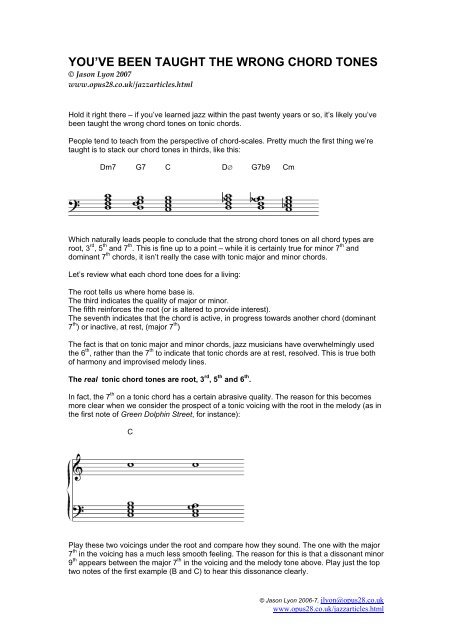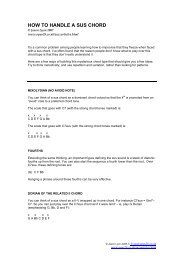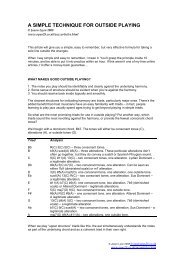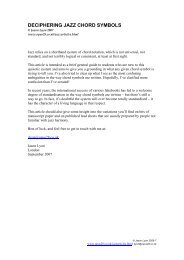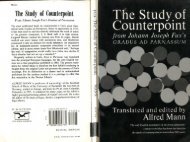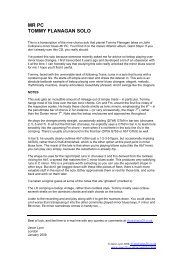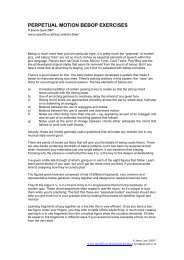YOU'VE BEEN TAUGHT THE WRONG CHORD TONES - Phill Fest
YOU'VE BEEN TAUGHT THE WRONG CHORD TONES - Phill Fest
YOU'VE BEEN TAUGHT THE WRONG CHORD TONES - Phill Fest
You also want an ePaper? Increase the reach of your titles
YUMPU automatically turns print PDFs into web optimized ePapers that Google loves.
Now it’s true to say that sometimes this mildly abrasive quality is actively preferred, certainlyin the context of 1960s jazz onwards. Particularly with chords from melodic minor, use of themajor 7 th was increasingly used from this period onwards.Nevertheless, if we’re talking about a “first choice” chord tone to make a tonic chord soundresolved, jazz musicians have always favoured the 6 th over the 7 th .Don’t believe me? Let’s look at the evidence.1. <strong>THE</strong> PIANIST’S LEFT HANDFor evidence of how jazz musicians have conceived chord tones in various periods of themusic’s development, it’s highly instructive to look at what pianists have played underneath amelody or RH solo.Ragtime, stride and swing piano voicings contained the 6 th on a tonic chord, not the 7 th . Thetypical shape is 1-3-5-6:CCmThe bebop shell voicings used by Bud Powell and his contemporaries are possible with a 7 th ,but much more common is the 6 th :C (or Cm)The rootless voicings popularised by Red Garland, Bill Evans and Wyn Kelly can use the 7 th ,but the most common shape is to play 3 rd and 5 th , add the 6 th and strengthen it with the 9 th :C CmFourth voicings are inherently more ambiguous. Chord tones are built in thirds (apart from ournew friend, the 6 th ), and the average hand can only span three fourths – so you’re only goingto be able to include two chord tones. This ambiguity is not a bad thing – it’s actually animportant part of the sound of 1960s jazz and beyond. The commonest fourth voicing for atonic chord contains 3 rd , 6 th and 9 th :© Jason Lyon 2006-7, jlyon@opus28.co.ukwww.opus28.co.uk/jazzarticles.html
C CmAgain avoiding the 7 th in favour of the 6 th . Incidentally, for all that they are “modernistic”, thesefourth voicings are really just thinned-out versions of the rootless voicings above.So, while pianists have certainly occasionally used tonic voicings with 7ths, the overwhelmingevidence is that they have regarded the “finalising” chord tone on a tonic as the 6 th not the 7 th ,throughout all periods of the music’s history.2. <strong>THE</strong> TONIC BEBOP SCALEThe rationale behind passing-tone scales, of which the most widely applied have come to beknown as the “bebop scales”, is to add consistent chromatic tones to the basic chord-scale sothat chord tones coincide with strong downbeats. This makes for much stronger melodicconstruction.Again, we find that the bebop scales used over tonic chords consider the chord tones to beroot, 3 rd , 5 th and 6 th (not 7 th ):C bebop scale Cm bebop scalex x x x x x x x(These are usually played descending.) Actually, it isn’t possible to add a chromatic tone to atonic scale so as to emphasise the 7 th . The root is a vital chord tone and a semitone doesn’texist between root and 7 th , so it’s impossible to emphasise both these tones in this kind ofbebop-style scalar eighth-note line.3. BLOCK <strong>CHORD</strong>S AND BASIC ARRANGING PRINCIPLESLet’s look at the block chord style developed by Milt Buckner, George Shearing and others forharmonising a melody with parallel moving voicings. The principle is to voice chord tones astonic 6 th chords and all other tones as dominant 7b9 chords:C© Jason Lyon 2006-7, jlyon@opus28.co.ukwww.opus28.co.uk/jazzarticles.html
We’ve added a passing tone so as to smoothly alternate I and V chords. (Flat the 3 rd and youhave the tonic minor version).This is called “four-way close” and is also the underpinning of many different styles ofarranging for horns. What we’ve effectively done is harmonise the tonic major and minorbebop scales. Again, the chord tones are considered to be root, 3 rd , 5 th and 6 th .4. PENTATONIC SCALESThe “gapped scale” sound was explored at length in the 1960s by musicians such asColtrane, McCoy Tyner, Chick Corea and Woody Shaw. If you’re tempted to think of the 6 th ona tonic as a rather vintage sound, belonging more to swing and bop than modern styles,guess again. Pentatonic scales also overwhelmingly favour the 6 th and omit the 7 th .Pentatonic scales are very flexible – there are many different types of pentatonic and they canbe applied over lots of different chord types.Having said that, the basic starting point is the major pentatonic scale:CThis pentatonic scale is a melodic resource that has been used throughout history in culturesthe world over. It contains the 6 th and no 7 th .Granted, there are plenty of other pentatonic possibilities over a tonic chord which do containthe major 7 th : for instance, G major pentatonic, D major pentatonic, F# half-diminishedpentatonic (these last two convert the chord to CM+4). It is interesting to note, however, thatthe overwhelming majority of these other possibilities contain the 6 th as well….Once you’ve taken this principle on board, you’ll find the improvised lines you play over tonicchords will immediately start to sound stronger. While it is possible to emphasise the major 7 thin an improvised line, the 6 th sounds much stronger and more idiomatically correct.There are plenty of examples of even very modern players using the 6 th in this way. Listen toTommy Flanagan’s solo on Mr PC (on the album Giant Steps), for instance. This is a minorblues, where the Cm chords are tonic chords – Tommy consistently uses the 6 th at thesepoints in his line.Learn how the 6 th sounds over a tonic chord and you’ll start to hear it everywhere.Best of luck with this approach. Free to e-mail me with any (preferably constructive)comments at jlyon@opus28.co.uk.Jason LyonLondonNovember 2007© Jason Lyon 2006-7, jlyon@opus28.co.ukwww.opus28.co.uk/jazzarticles.html


